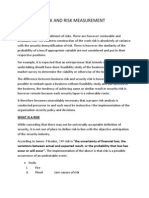What Is A Marketing Mix
What Is A Marketing Mix
Uploaded by
stephanie lopezCopyright:
Available Formats
What Is A Marketing Mix
What Is A Marketing Mix
Uploaded by
stephanie lopezOriginal Title
Copyright
Available Formats
Share this document
Did you find this document useful?
Is this content inappropriate?
Copyright:
Available Formats
What Is A Marketing Mix
What Is A Marketing Mix
Uploaded by
stephanie lopezCopyright:
Available Formats
What Is a
Marketing Mix?
A marketing mix includes multiple areas of
focus as part of a comprehensive marketing
plan. The term often refers to a common
classification that began as the four Ps: product,
price, placement, and promotion.
Effective marketing touches on a broad range of
areas as opposed to fixating on one message.
Doing so helps reach a wider audience, and by
keeping the four Ps in mind, marketing
professionals are better able to maintain focus
on the things that really matter. Focusing on a
marketing mix helps organizations make
strategic decisions when launching new
products or revising existing products.
Key Takeaways
A marketing mix refers to a framework
that uses the four Ps of product, price,
placement, and promotion.
This concept traces back to 1960, when marketing professor E. Jerome McCarthy first
published it in a book entitled Basic Marketing: A Managerial Approach.
The different elements of a marketing mix work in conjunction with one another with
the ultimate purpose of generating higher sales.
In addition to the 4 Ps, three approaches can also be integrated that include people,
process, and physical evidence to reinforce a consumer-centric type of marketing
strategy.
This type of strategy extends beyond a product-focused marketing approach.
What Are the 4 Ps of a Marketing Mix?
The four Ps classification for developing an effective marketing strategy was first introduced
in 1960 by marketing professor and author E. Jerome McCarthy.1 It was published in the
book entitled Basic Marketing: A Managerial Approach. Depending on the industry and the
target of the marketing plan, marketing managers may take various approaches to each of the
four Ps. Each element can be examined independently, but in practice, they often are
dependent on one another.
Product
This represents an item or service designed to satisfy customer needs and wants. To
effectively market a product or service, it's important to identify what differentiates it from
competing products or services. It's also important to determine if other products or services
can be marketed in conjunction with it.
Price
The sale price of the product reflects what consumers are willing to pay for it. Marketing
professionals need to consider costs related to research and development, manufacturing,
marketing, and distribution—otherwise known as cost-based pricing. Pricing based primarily
on consumers' perceived quality or value is known as value-based pricing. IMPORTANT:
Value-based pricing plays a key role in products that are considered to be status symbols.
Placement
When determining areas of distribution, it's important to consider the type of product sold.
Basic consumer products, such as paper goods, often are readily available in many stores.
Premium consumer products, however, typically are available only in select stores.
Promotion
Joint marketing campaigns are called a promotional mix. Activities might include advertising,
sales promotion, personal selling, and public relations. One key consideration is the budget
assigned to the marketing mix. Marketing professionals carefully construct a message that
often incorporates details from the other three Ps when trying to reach their target audience.
Determination of the best mediums to communicate the message and decisions about the
frequency of the communication also are important.
What Are Other Marketing Tools?
Not all marketing is product-focused. Customer service businesses are fundamentally
different than those based primarily on physical products, so they often will take a consumer-
centric approach that incorporates additional elements to address their unique needs.
Three additional Ps tied to this type of marketing mix might include people, process, and
physical evidence. "People" refers to employees who represent a company as they interact
with clients or customers. "Process" represents the method or flow of providing service to
clients and often incorporates monitoring service performance for customer satisfaction.
"Physical evidence" relates to an area or space where company representatives and
customers interact. Marketers take into consideration elements such as furniture, signage, and
layout.
Additionally, marketers often study consumers in order to refine or update strategies related to
services or products. This requires a strategy for communicating with consumers in order to
obtain feedback and define the type of feedback being sought.
Traditionally, marketing commences with identifying consumers' needs and ceases with the
delivery and promotion of a final product or service. Consumer-centric marketing is more
cyclical. Its goals include reassessing customers' needs, communicating frequently, and
developing strategies to build customer loyalty.
What Are the Four Elements of a Marketing Mix?
The four primary elements of a marketing mix are product, price, placement, and promotion.
This framework aims to create a comprehensive plan to distinguish a product or service from
competitors that creates value for the customer. Often, these elements are dependent on each
other.
Product refers to a good or service that meets a customer's needs. Here, companies focus on
features that differentiate it from its competitors. An organization may also consider
complementary products that fit within its suite of product or service offerings.
Price represents the price point or price range for the product or service. Ultimately, the goal
is to maximize profit margins and return on investment while considering the price that
customers are willing to pay.
Placement refers to distribution channels. Specifically, where is this product being promoted,
and how can you get it in front of your target audience?
Promotion focuses on creating brand awareness around your product or service. Importantly,
it looks at how utilizing certain channels can drive sales.
What Are the 7 Ps in a Marketing Mix?
Sometimes, the marketing mix can extend beyond the classic four Ps of product, price,
placement, and promotion established by professor E. Jerome McCarthy in 1960. These
additional categories include people, physical evidence, and process.
In this way, people represent the employees who interact with customers. A company may
consider company culture as it relates to its brand strategy. This may include customer
relationship management (CRM), which aims to increase brand loyalty among customers.
Physical evidence might include the packaging or the layout of a physical store, which can
reinforce a brand and create more value to the customer.
Finally, the process identifies areas, often from a logistical standpoint, that enable the
customer to have the most seamless experience possible with a product or service. This may
include everything from delivery logistics and shipping to managing third-party retailers.
What Is the Purpose of a Marketing Mix?
At its core, a marketing mix is focused on promoting a product or service to generate revenue
for a company. On the whole, it integrates key marketing strategies that create brand
awareness, build customer loyalty, and drive product sales.
The Bottom Line
The development of a comprehensive, effective marketing plan takes into consideration a
marketing mix that includes several areas of focus. Typically, the marketing mix refers to the
four Ps: product or service, its price, placement, and promotion. This concept was developed
in 1960, when marketing professor E. Jerome McCarthy first published it in a book entitled
Basic Marketing: A Managerial Approach.
However, because not all marketing is focused on products, customer-service businesses rely
on other marketing tools that might include three additional Ps: the people who interact with
customers, the process that creates a seamless customer experience, and physical evidence, or
the area where customers and company representatives interact.
All of these tools are used to promote a product or service and build brand awareness and
customer loyalty in order to generate revenue for a business.
Investopedia requires writers to use primary sources to support their work. These include
white papers, government data, original reporting, and interviews with industry experts. We
also reference original research from other reputable publishers where appropriate. You can
learn more about the standards we follow in producing accurate, unbiased content in our
editorial policy.
1. E. Jerome McCarthy. "Basic Marketing: A Managerial Approach,"
https://hdl.handle.net:2027:inu.30000041584743,” Page vi. R.D. Irwin, 1960.
You might also like
- The Marketing Mix: Master the 4 Ps of marketingFrom EverandThe Marketing Mix: Master the 4 Ps of marketingRating: 5 out of 5 stars5/5 (4)
- 4ps PDFDocument6 pages4ps PDFmehul bariNo ratings yet
- Marketing StrategiesDocument2 pagesMarketing StrategiesAnji JoguilonNo ratings yet
- Manu Kant: Executive SummaryDocument6 pagesManu Kant: Executive SummarymanukleoNo ratings yet
- Risk and Risk MeasurementDocument18 pagesRisk and Risk MeasurementEzekiel Ogaga OvbioghorNo ratings yet
- What Is A Marketing MixDocument2 pagesWhat Is A Marketing MixBek AhNo ratings yet
- Wa0000.Document1 pageWa0000.Veronia MinaNo ratings yet
- MM CIA 3 MARKETING MixDocument1 pageMM CIA 3 MARKETING MixSHIVAM GUPTA 2028348No ratings yet
- 5 Ps of MarketingDocument2 pages5 Ps of Marketingsania mehmoodNo ratings yet
- Marketing MixDocument14 pagesMarketing Mixmarwaaitalla1No ratings yet
- 1 Markerting MixDocument16 pages1 Markerting MixAna Kristelle Grace SyNo ratings yet
- Explain The Four Ps of The Marketing MixDocument2 pagesExplain The Four Ps of The Marketing MixSex video Indian Full HDNo ratings yet
- Santhosh ProjectDocument12 pagesSanthosh Projectsandy santhoshNo ratings yet
- Marketing MixDocument7 pagesMarketing MixharshNo ratings yet
- NotesDocument3 pagesNoteszunairajawwadbaigNo ratings yet
- Marketing PrinciplesDocument6 pagesMarketing PrinciplesmukukakowaNo ratings yet
- D. Company Orientation Toward The MarketplaceDocument2 pagesD. Company Orientation Toward The MarketplaceSean Chris ConsonNo ratings yet
- BHM Marketing MixDocument3 pagesBHM Marketing Mixad771918No ratings yet
- Tourism and Hospitality MarketingDocument5 pagesTourism and Hospitality MarketingAsh Jehan BernalNo ratings yet
- Marketing Mix in The Development of Marketing StrategyDocument15 pagesMarketing Mix in The Development of Marketing StrategyGladys GaleraNo ratings yet
- Chapter-1 Plan of StudyDocument14 pagesChapter-1 Plan of StudyAman RanaNo ratings yet
- Marketing MixDocument1 pageMarketing Mixoumaima ajbilouNo ratings yet
- Sapna Rana Bba LLB AssignmentDocument6 pagesSapna Rana Bba LLB AssignmentSapna RanaNo ratings yet
- A Study On Consumers Perception Towards Micromax MobilesDocument91 pagesA Study On Consumers Perception Towards Micromax MobilesAbhisekh Tripathy100% (1)
- MarketingDocument49 pagesMarketingLeyte DanaoNo ratings yet
- Marketing Mix 4psDocument7 pagesMarketing Mix 4psMir FaisalNo ratings yet
- Understanding MarketingDocument10 pagesUnderstanding MarketingvsnpradeepNo ratings yet
- A Study of Marketing Mix On Samsung Mobiles: Chapter - 1Document83 pagesA Study of Marketing Mix On Samsung Mobiles: Chapter - 1sandy santhoshNo ratings yet
- Marketing Management NotesDocument115 pagesMarketing Management NotesKajwangs DanNo ratings yet
- Marketing MixDocument13 pagesMarketing MixArpit GuptaNo ratings yet
- Marketig MixDocument8 pagesMarketig MixAbhishek TyagiNo ratings yet
- Patanjali Minor ProjectDocument49 pagesPatanjali Minor ProjectANUKRITNo ratings yet
- Marketing Management & Decision Making, Organization and Marketing ConceptsDocument29 pagesMarketing Management & Decision Making, Organization and Marketing ConceptsMaria AleniNo ratings yet
- What Is MarketingDocument2 pagesWhat Is Marketingneha shaikh100% (1)
- 20087ipcc Paper7B Vol2 Cp5Document26 pages20087ipcc Paper7B Vol2 Cp5Piyush GambaniNo ratings yet
- KPR Agrochem LTDDocument66 pagesKPR Agrochem LTDpronoyalfiNo ratings yet
- Business Enterprise Simulation Module Week 7Document2 pagesBusiness Enterprise Simulation Module Week 7Judel GarciaNo ratings yet
- 4 Ps Marketing MixDocument4 pages4 Ps Marketing MixTATENDA MUZENDANo ratings yet
- ProjectDocument79 pagesProjectbhagathnagar0% (1)
- What Is Marketing Mix?Document5 pagesWhat Is Marketing Mix?Zubair JuttNo ratings yet
- Concept of The Marketing Mix 4Ps Why It Is Important To Understand The Concept of The Marketing Mix 4PsDocument3 pagesConcept of The Marketing Mix 4Ps Why It Is Important To Understand The Concept of The Marketing Mix 4PsYessi CarolineNo ratings yet
- Marketing Communications Plan For New ProductDocument3 pagesMarketing Communications Plan For New Productanon_425120586No ratings yet
- Question One: Write A Note On Marketing MixDocument1 pageQuestion One: Write A Note On Marketing MixseemabNo ratings yet
- 3 17 22 Narita AhujaDocument5 pages3 17 22 Narita Ahujaa_wyneNo ratings yet
- Marketing MixDocument1 pageMarketing MixAngelica Ibana VicencioNo ratings yet
- Marketing MixDocument41 pagesMarketing MixPurav BothraNo ratings yet
- The Marketing MixDocument13 pagesThe Marketing MixCharmaine KeidyNo ratings yet
- 5 - Marketing Mix Notes 26-11-23Document11 pages5 - Marketing Mix Notes 26-11-23S.G. GroupNo ratings yet
- Chapter II - Marketing AspectDocument25 pagesChapter II - Marketing AspectJewel CruzNo ratings yet
- Understanding The Marketing Mix Concept - 4P: Prepared By: Divine Grace M. Jasa BSBA Mktg. MajorDocument5 pagesUnderstanding The Marketing Mix Concept - 4P: Prepared By: Divine Grace M. Jasa BSBA Mktg. MajorDivine Grace JasaNo ratings yet
- FUNDAMENTALS OF MARKETING (Abridged)Document16 pagesFUNDAMENTALS OF MARKETING (Abridged)ogunleyeadewunmiNo ratings yet
- Definition: The Art and Science of Choosing Target Markets and Getting, Keeping, RowingDocument8 pagesDefinition: The Art and Science of Choosing Target Markets and Getting, Keeping, RowingRand EmmadiNo ratings yet
- The Marketing MixDocument12 pagesThe Marketing MixMei Ferdin ZaiNo ratings yet
- Marketing ManagemntDocument76 pagesMarketing ManagemntPratha JainNo ratings yet
- Exclusivity MarketingDocument40 pagesExclusivity Marketingalifahadmz04No ratings yet
- Element of Strategic MarketingDocument15 pagesElement of Strategic MarketingAishatu Musa AbbaNo ratings yet
- Assignment #1 (Marketing Management)Document7 pagesAssignment #1 (Marketing Management)shahrozs974No ratings yet
- MarketingDocument76 pagesMarketingVishal ChandakNo ratings yet
- MarketingDocument8 pagesMarketingRajesh AppariNo ratings yet
- Aashay JaiswalDocument62 pagesAashay JaiswalAvinash Sahu100% (1)
- Promotion Marketing Mix System Personal Selling Advertising Sales Promotion Direct Marketing Publicity Money Budget Objectives BrandDocument8 pagesPromotion Marketing Mix System Personal Selling Advertising Sales Promotion Direct Marketing Publicity Money Budget Objectives BrandValentineJoao100% (1)
- Redox Flow Battery PDFDocument9 pagesRedox Flow Battery PDFpedro_cabezas_2No ratings yet
- The Dance of Condong Legong Keraton in Yogyakarta: Transfer The Character Education To ChildrenDocument7 pagesThe Dance of Condong Legong Keraton in Yogyakarta: Transfer The Character Education To ChildrenNi Luh Enita MaharaniNo ratings yet
- Math111 Chapter 12 Higher-Order Derivatives and Implicit DifferentiationDocument6 pagesMath111 Chapter 12 Higher-Order Derivatives and Implicit DifferentiationAbdul Halil AbdullahNo ratings yet
- Assessment of Groundwater Quality and Saline Water Intrusion in The Coastal Aquifers of Purba Midnapur DistrictDocument11 pagesAssessment of Groundwater Quality and Saline Water Intrusion in The Coastal Aquifers of Purba Midnapur DistrictDhrubaNo ratings yet
- Invigilator Roles and ResponsibilitiesDocument38 pagesInvigilator Roles and ResponsibilitiesAsif Yaqub Khan100% (1)
- Lecture 1 Asymptotic NotationsDocument30 pagesLecture 1 Asymptotic NotationsQoryNo ratings yet
- NEG3MathPTPaper 12 06 10Document6 pagesNEG3MathPTPaper 12 06 10Mary Lou m. VelezNo ratings yet
- Fan Impeller Concept DesignDocument15 pagesFan Impeller Concept DesignLucky Cham AguilaNo ratings yet
- Mmi Um013 - en PDocument148 pagesMmi Um013 - en PtaharNo ratings yet
- Pascual CO2 PositionPaper2Document2 pagesPascual CO2 PositionPaper2Franchezcka PascualNo ratings yet
- Civil Engineering Technology - Higher National Diploma (HND) : Curriculum Table - 1597860069576Document4 pagesCivil Engineering Technology - Higher National Diploma (HND) : Curriculum Table - 1597860069576Stephen Torwoedzor67% (3)
- Confined SpacesDocument38 pagesConfined SpacesKilli Ndutz SuperHolicNo ratings yet
- 742236V01Document2 pages742236V01David Antonio Matias VelascoNo ratings yet
- METSABOARDDocument1 pageMETSABOARDAlex GonzalezNo ratings yet
- BHR PR LitDocument4 pagesBHR PR Litdonald duckNo ratings yet
- Acccob 2 Portfolio: Reflection Paper Presented To The Accountancy DepartmentDocument6 pagesAcccob 2 Portfolio: Reflection Paper Presented To The Accountancy DepartmentRafael CaparasNo ratings yet
- Understanding The Self Syllabus 2nd Sem 2021-22Document7 pagesUnderstanding The Self Syllabus 2nd Sem 2021-22Mary Crisza RentoriaNo ratings yet
- Introduction To HiveDocument28 pagesIntroduction To Hivefab vifNo ratings yet
- 40.4 Project Schedule-NewDocument1 page40.4 Project Schedule-NewTanvir Shawon100% (1)
- Digital and Social Media MarketingDocument17 pagesDigital and Social Media Marketingegy1971No ratings yet
- Yealink - SIP-T21P-E2 - Datasheet - by LATNOK CDDocument2 pagesYealink - SIP-T21P-E2 - Datasheet - by LATNOK CDCoko Mirindi MusazaNo ratings yet
- TKT Clil HandbookDocument30 pagesTKT Clil HandbookWawa ChenNo ratings yet
- AutacoidsDocument43 pagesAutacoidsOdiete EfeNo ratings yet
- Discrete MathematicsDocument23 pagesDiscrete MathematicsccchengchuuuNo ratings yet
- Photosynthesis TestDocument4 pagesPhotosynthesis TestLester Eslava OrpillaNo ratings yet
- Ug903 Vivado Using ConstraintsDocument152 pagesUg903 Vivado Using ConstraintsJenniferNo ratings yet
- Gershwin American in Paris Cor - AnglaisDocument8 pagesGershwin American in Paris Cor - AnglaisDavid AllenNo ratings yet
- ESM 4.0 - Brochure by Es Sanjay AgrawalDocument23 pagesESM 4.0 - Brochure by Es Sanjay Agrawalganeshbiswal255No ratings yet

























































































